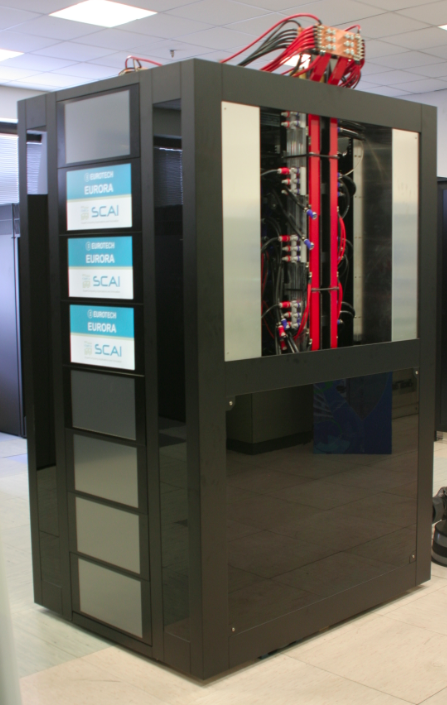You are here
Eurotech Eurora, the PRACE prototype deployed by Cineca and INFN, scores first in Green500 list

The Eurora supercomputer is ranked 1st in the June 2013 Green500 chart. The combination of the energy efficient Eurotech design and the high-performance efficiency of the NVIDIA® Tesla® GPU- accelerators allowed the engineering of the world’s most efficient supercomputer with measured 3210 MFlop/s per Watt.
Eurora serves as the base technology for the development of the PRACE 2IP co-funded prototype, a project with the same name “Eurora” led by the Cineca supercomputing center in Italy. Cineca deploys the Eurora prototype to advance research and discovery in the fields of computational sciences, including fundamental constituents of matter, condensed matter, astrophysics, the life sciences, and Earth sciences in agreement and collaboration with the Italian academic research system, the National Institute of Nuclear Physics (INFN), the National Research Council (CNR), the International School for Advanced Study (SISSA – ISAS) and the National Institute of Geophysics and Oceanography (OGS).
The Eurora co-designed production prototype is intended to progress in the optimization of the energy efficient high performance computing system towards the deployment of exascale computing system with a total cost of ownership affordable and sustainable.
“Advanced computer simulations that enable scientists to discover new phenomena and test hypotheses require massive amounts of performance. The scalability of the high energy efficiency is a fundamental problem to solve and we are proud of this initial outcome of ours R&D activity in collaboration with Eurotech and National Institute of Nuclear Physics - INFN” said Sanzio Bassini, Director of HPC Department at Cineca “Equipped with the ultra-efficient Aurora system and NVIDIA GPU accelerators, Eurora will give European researchers the computing muscle to study all types of physical and biological systems, while allowing us to keep data center power consumption and costs in check.”
 The Eurora supercomputer is accelerated by NVIDIA Tesla K20 GPU accelerators based on NVIDIA Kepler™, the world’s highest performance and most efficient high-performance computing architecture. It provides the base for the commercial Eurotech Aurora Tigon, expanding the Eurotech Aurora supercomputer product line to include new energy-efficient, high-performance GPU-accelerated systems.
The Eurora supercomputer is accelerated by NVIDIA Tesla K20 GPU accelerators based on NVIDIA Kepler™, the world’s highest performance and most efficient high-performance computing architecture. It provides the base for the commercial Eurotech Aurora Tigon, expanding the Eurotech Aurora supercomputer product line to include new energy-efficient, high-performance GPU-accelerated systems.
The Cineca Eurora supercomputer is equipped with two Intel Xeon E5-2687W CPUs and two PCI-e connected NVIDIA Tesla K20 accelerators per node. Water cooling and electronics design allows for very high densities to be reached with a peak performance of 350 TFlop/s per rack.
“The Eurora record efficiency result is enabled by the energy efficiency and performance driven Eurotech design leveraging the NVIDIA Tesla K20 accelerators” – said Giampietro Tecchiolli, Eurotech CTO – “In addition to that, Eurotech’s Aurora Hot Water Cooling technology allows “free cooling”, air conditioning avoidance, in warm climates like the Italian one, reaching record low data center PUE values (1.05), while providing complete flexibility on data center location”
The Eurora and the Aurora Tigon systems not only benefit from system energy efficiency, but also make the entire data center more efficient and more compact, providing energy and space savings that can reduce TCO by an average of 30%-50%. Compared to a conventional air-cooled system, Aurora HPCs enable data centers to save up to 50% on energy bills, while reducing space occupancy by 5 times due to higher density system configurations.
Eurora contributes to add another liquid cooled system to the top Green 500 positions, demonstrating how technology like the Aurora direct hot liquid cooling adopted by Cineca, not only make data centers greener by saving energy, but also contribute to the efficiency of the HPC machines.
Speaking about “green” implications, the 100 TFlop/s Eurora system, when compared to an equivalent performance air cooled system in the same Mediterranean climate, brings a reduction of more than 2,300 tons of CO2 emissions per rack in 5 years. In addition, the water heated up in the Aurora systems can be re-used to heat buildings, drive adsorption chillers for air conditioning or allow for trigeneration, the combined production of electricity, heating and cooling.
